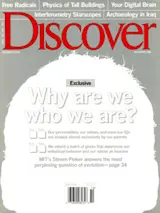Summer thunderstorms in the Midwest are confounding: They strike quick, hit hard, and materialize out of nowhere. "If you look at a radar screen, it looks like a storm happens in one place, goes away, then a whole group of totally unrelated storms grows up a few hundred miles away," says meteorologist Richard Carbone of the National Center for Atmospheric Research in Boulder, Colorado. But when Carbone and his colleagues analyzed 50,000 radar images of thunderstorms that occurred between 1997 and 2000, they uncovered a previously undetected pattern. "As systems die, they cause the birth of new groups of thunderstorms in a very systematic way," he says. One storm triggers another and so on, creating ripples of rain that move west to east from the eastern edge of the Rockies to the Appalachian Mountains.
Carbone suspects that the ripple effect is driven by enormous atmospheric waves resulting from differences in ...














